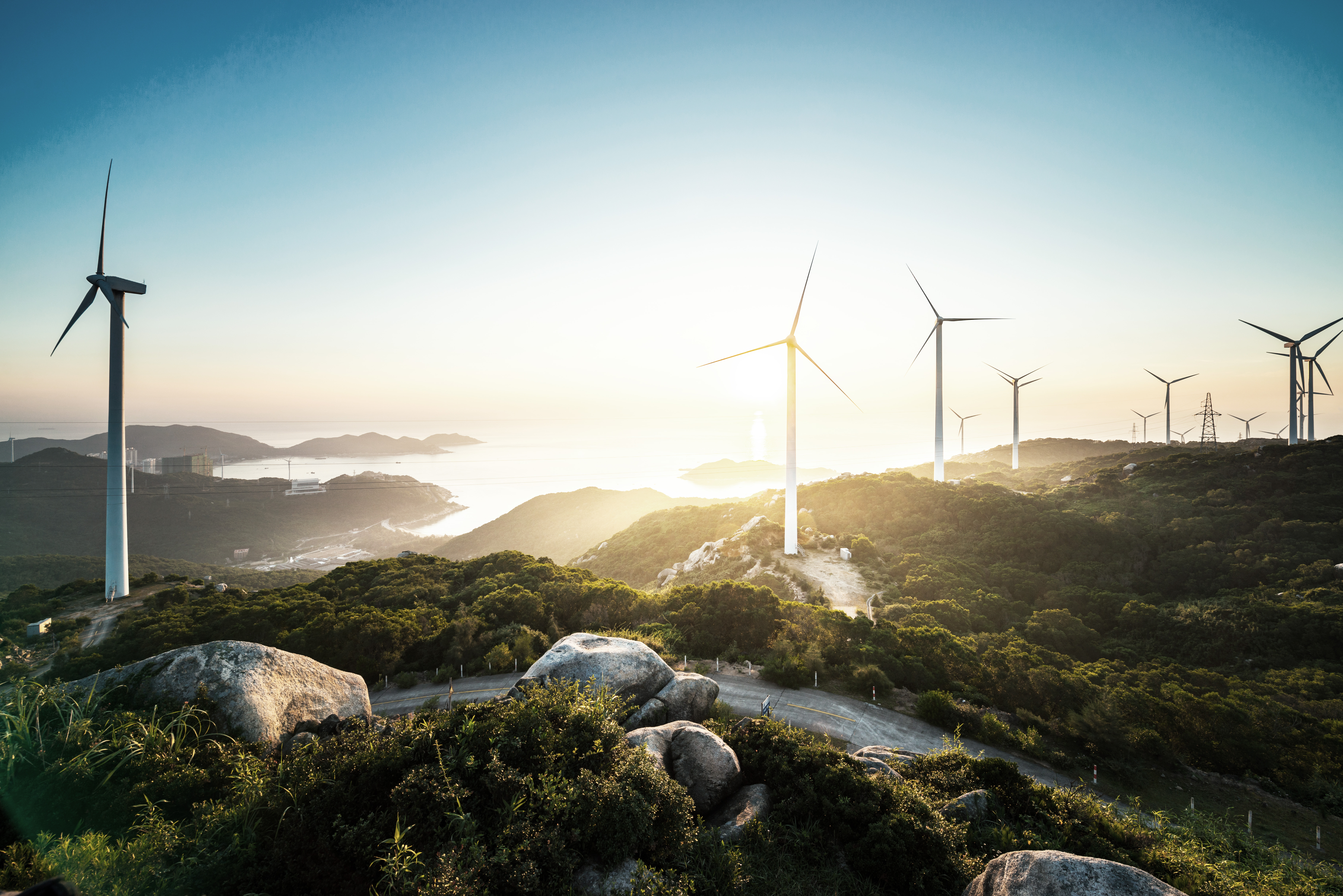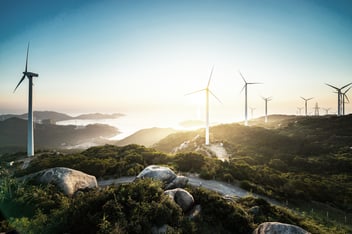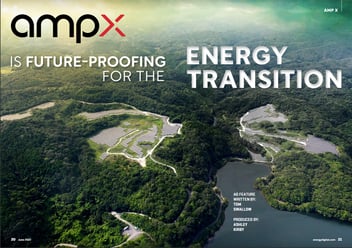Setting New Trends in European Wind Power – Jorge Calvet, Head of Amp Spain

-1.jpg)
With two gigawatts of projects in development, the head of Amp Energy’s new Spanish division believes hybridized wind power holds the key to reducing Europe’s carbon emissions, strengthening communities, and improving energy security.
The story of Spain’s wind industry is one of remarkable progress, challenging setbacks, and, more recently, renewed determination. After being one of the earliest countries to embrace large-scale wind power, the global financial crisis and resulting fallout brought Spanish wind development to a virtual standstill between 2012 and 2015. However, recent years have seen the country regain its momentum to become the world’s 5th largest producer of wind energy and second in Europe only to Germany. Today, wind accounts for around 20% of Spain’s total energy supply, with more than 1,200 wind farms spread across 1,000 municipalities.
Jorge Calvet is Amp’s Executive Vice President and heads the company’s newly established Spanish operations headquartered in Madrid. As an industry veteran, including formerly serving as chairman and CEO of leading turbine manufacturer Gamesa, Jorge and his team bring comprehensive wind industry experience and a Spanish portfolio of approximately two gigawatts currently in development.
“Spain was a global wind leader in the early 2010s, and to reclaim this position, the government has decided to be even more aggressive than the renewable energy targets laid out by the EU,” Jorge said. “After a few years of slowed growth, it’s now full-steam ahead.”
“Spain is a great market for solar farms, but it’s phenomenal for wind energy because of the incredible wind resources it has throughout the country.”
In early 2020, Spain announced a ten-year plan to install 22GW of new onshore wind generation by 2030. Despite the challenges of the Coronavirus pandemic, it turned out to be a tremendous year for the Spanish wind industry, installing 1.7GW of new capacity and achieving one of its largest annual totals of the last decade.
“Now that Amp has a wind division with a large development pipeline, we’re very busy with existing and new projects here in Spain, as well as some exciting potential M&A opportunities. At the same time, when my Amp colleagues need support with new wind projects, we now have the specific knowledge and expertise to help move them forward,” Jorge said. “We’re currently in talks about a promising development in Canada, and my team and I are looking forward to increasing the role of wind power across the entire Amp spectrum.”
The Unique Challenges of Wind Development
Throughout its journey to becoming a leading global developer, owner, and operator of renewable energy assets, Amp has traditionally focused on solar and, more recently, large-scale battery storage. However, the addition of the company’s wind division opens up many new opportunities, as well as unique technical and logistical challenges.
“Wind development requires very specialized expertise. Compared to solar, it's much heavier on the technical side, especially with the continual push to make turbines larger and more efficient,” Jorge said. "There’s also more considerations about how to organize wind farms because you have some factors that you don’t have with solar, such as wind shear, bird flight paths, and how to optimally locate turbines so that they don’t compete with each other.”
Having identified a potential site, the development team records detailed wind measurements using towers up to 100m (320 feet) tall. “We need to have at least one year of measurements to confirm the project’s viability and also to meet the financing requirements of the banks,” Jorge said. “We can also source a tremendous amount of information from databases and other resources, including laser-based LiDAR systems.”
As a project moves forward, the team then performs micrositing of the area and begins planning the turbine layout and assessing the civil works. As colossal structures with tower heights of up to 150m (500 feet), the logistical challenge of transporting and erecting wind turbines has become something of an engineering art form.
“Installing turbines in mountain ranges is incredibly complicated. And as blades become longer, we’re continually working with crane and truck operators to engineer smarter and more efficient solutions.”
“Logistics is definitely one of the most challenging aspects of wind development, particularly in Europe where it’s very difficult to move turbines that are larger than six megawatts. Blades can be more than 65 meters (210 feet) long, so transporting them requires a coordinated network of cranes, trucks, and trains, which is particularly complex in winding mountainous regions,” Jorge said.
“Europe’s rail network largely stems from the post-WW2 era, so its bridges and tunnels were never designed with this type of transport in mind. So, if we’re installing a turbine at the peak of a mountain, it’s not unheard of to deliver the blades with helicopters, and it’s only with a lot of specific industry knowledge and experience that we can manage all of that.”
Improving Europe’s Energy Security
2021 has been a year of soaring energy prices in Spain and throughout Europe, driven by the rising costs of natural gas and its impacts on the electricity market. The energy crisis prompted Spanish lawmakers to impose emergency measures that capped gas prices and reduced electricity taxes to help relieve struggling consumers in the lead-up to winter.
“One of the main reasons why we’ve seen European gas prices going up is because the EU is highly dependent on external sources of energy. Europe buys a lot of gas from Russia via pipelines and also imports from countries such as the US, Algeria, Trinidad and Tobago, and Saudi Arabia. So with the current geopolitical scene, it’s increasingly complicated and expensive to rely on these external sources.”
Russia is currently the EU’s largest natural gas supplier, responsible for around 40% of all imports during 2019 and 2020. Spain produces almost no natural gas of its own and relies heavily on imports from Algeria, which provides around half of the county’s total reserves.
“The gas crisis is the perfect opportunity for European countries to accelerate their transition to cleaner, cheaper, and more localized renewable energy.”
Jorge believes the combination of rising energy costs and the EU’s goal of net-zero emissions by 2050 will only accelerate Spain’s rollout of renewable energy. In early 2021, the Spanish government passed a "milestone” clean energy bill stating that renewables will supply at least 42% of the country’s total energy by 2030 and at least 74% of its electricity generation.
“Developing more wind and solar is absolutely critical for Europe’s energy independence, particularly for countries like Spain that rely so heavily on imports,” he said. “I’m confident that recent events and the growing momentum to decarbonize will continue driving the EU and its members along this renewable energy path. For a variety of different reasons, we believe renewables are clearly the way forward.”
Amp’s New Era of Hybridized Wind Farms
As part of Amp’s vision to accelerate the global adoption of renewable energy, Jorge’s team is taking a multi-technology approach to its wind farm development. “Every wind project in our Spanish portfolio will be hybridized with battery storage, and some will include solar energy as well,” he said. “Incorporating battery storage not only increases reliability and improves our ability to deliver electricity, but it’s now actively encouraged by the Spanish government,” he said.
Spain is yet to create legislation for standalone energy storage projects, but Amp is currently one of the only wind developers in Europe adopting a hybrid wind model. “The Spanish regulations are such that where we participate in tenders, proposing a hybridized wind farm with batteries gives us a distinct advantage over standalone projects,” Jorge said. “Hybridization definitely separates Amp from many of our competitors, and I certainly see the regulations throughout Europe going the same way in the future.”
Jorge and his team will also look to incorporate Amp’s proprietary digital energy platform, Amp X, across the wind portfolio, which will provide turbine and battery management services over the lifetime of each project. "Amp X will help to maximize each asset’s readiness and uptime while providing real-time visibility of system health and performance tracking against specific parameters,” he said. “As every wind asset will include batteries, Amp X’s artificial intelligence will help us to store and dispatch energy in the most efficient, cost-effective manner, which is becoming critical in these very complex and fast-moving energy markets.”
“Amp is definitely at the forefront of developing the hybrid renewable energy model, which is a critical piece of our overall strategy.”
In addition to reducing intermittency and delivering on-demand renewable energy, battery storage is also proving to be a cheaper and more effective alternative to expensive infrastructure upgrades.
“The interconnection with existing grids is one of the biggest challenges that renewables face in achieving the deployment levels the world requires. We’re seeing it in markets such as the US, Latin America, Australia, and particularly in Spain, where there is a lot of focus on building out grid infrastructure,” he said. “Batteries not only increase the performance and reliability of our assets, but also play a key role in reducing these bottlenecks and creating a more diversified and resilient energy network.”
Building Stronger Wind-Powered Communities
Wind farms feature many large turbines spread over expansive land areas, and Jorge says it’s critical to have a community-focused approach in which all residents can realize the benefits of renewable energy.
“We believe it’s critical to instill strong environmental, social, and governance (ESG) principles into every one of our projects,” he said. “We’re continually working to identify and minimize any environmental or social impacts our projects may have. And as the lifetime owner and operator of each asset, we seek to understand how we can strengthen these communities as we become stakeholders in the area.”
Jorge says there’s also a growing emphasis on conducting detailed environmental studies during the initial stages of development. With wind and solar farms having significant physical footprints, correctly assessing their potential impacts has become pivotal in securing community and government support.
“Our studies are very delicate and extensive, and we work through all of the relevant social and environmental impacts with local municipalities, residents, and NGOs,” he said. “We take at least one year of measurements, including studies to assess bird flight paths and migration patterns. It’s something Amp takes very seriously, and in my experience, it’s a critical factor in gaining community support to successfully develop a wind farm.”
“We engage all stakeholders in our wind farm development so that when residents see a turbine being installed in their area, they feel it’s a welcome addition to their local community.”
With European renewables set for dramatic expansion over the coming decade, Jorge says there’s also a growing emphasis on developing “dual-use” projects. “Wherever we can, we try to combine the wind installation with the existing activities on the land, so there’s minimal or zero impact on the landowner, and they can also enjoy the financial benefits of hosting a turbine on their property,” he said.
“More and more, I think we will see agriculture and livestock combined with renewable energy, as we’re already seeing with Amp’s solar development team in the US.”
Staying Ahead of Wind Sector Trends
Jorge stresses that in the rapidly evolving wind industry, it’s critical to maintain an end-to-end approach that encompasses manufacturing, transport, and construction.
“There’s a lot of technological innovation being incorporated into wind turbines, particularly in the field of power electronics, which provide far greater efficiency and control than we had ten or fifteen years ago,” he said. “There’s also a lot of research into alternative materials to reduce the costs of building the towers. Traditionally, they’ve been made of steel, but now we’re seeing hybrid towers made of two-thirds cement and one-third steel. We’re also seeing early plans to build towers with 3D printers, which has a lot of promise from cost and logistical perspectives, but that’s a bigger challenge requiring a lot more R&D.”
While the offshore wind sector is currently in an arms race to build larger and larger turbines, Jorge says Amp’s onshore wind portfolio is more focused on practical innovations that improve efficiency.
“Wind turbines are definitely growing in size. When I started in the industry, we had turbines of two megawatts, and now we’re trending towards fifteen megawatts in some offshore projects. But for onshore wind, while the size of a turbine is important, it’s not the critical factor,” he said. “There’s more focus on improving wind turbine efficiency to maximize generation in low wind speeds, which is driving the development of models with smaller towers but larger blades.”
“One of Amp’s key advantages is our speed of execution. We’re an extremely flexible and hands-on organization, which allows us to make considered decisions very quickly.”
Jorge is confident that Amp’s hybridized wind model and the incorporation of Amp X hold the company in good stead to become one of Europe’s leading renewable energy developers. “Once we have consolidated our existing opportunities here in Spain, we’re in a terrific position to expand into other countries such as Italy and France, which have very ambitious development plans for onshore wind. Then there’s also the Scandanavian countries, and potentially also the UK,” Jorge said.
“Whether it’s driven by decarbonization, cost reductions, or energy security, renewables are one of the keys to Europe’s future, and my team and I here at Amp are very proud to be leading this transition.”






